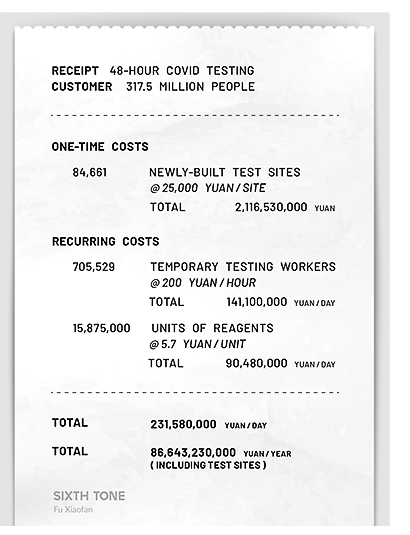
What Does it Cost to Test China for COVID-19?
As China moves on from an Omicron outbreak that disrupted life in many major cities, it’s leaving behind a new routine: near-daily PCR testing.
Across China, major cities are requiring people to test every 48 or 72 hours in order to go to work, shop, or get on public transport.
It’s part of the country’s strategy to achieve “zero-COVID” without cratering the economy. First launched in Hangzhou and Shenzhen in March, the system is now in place in nearly 20 major cities.
With hundreds of millions of people seeking tests a few times a week, wait times can get very long. In Shanghai’s first week, many people have reported spending an hour or more lining up. If these lines are going to get under control, cities will need a lot of new test kiosks.

That’s a huge new system. We wanted to know just how big — how many test sites does the country need, how many people need to staff them, and how much will it cost? Based on publicly available information, we’ve made some estimates.
How many test sites?
Question one: how many test sites does each city need?
Most major cities in the country now require a 48-hour COVID-19 test to enter public places, even if they do not require everyone to be tested every two days. While some cities — including Shanghai, China’s largest city — have a looser 72-hour requirement, we’ll use the more common 48-hour figure for our estimate.
The National Health Commission estimates that a city needs at least one test site for every 2,000 to 3,000 people. So we divided the population of a city by 3,000 to get a bare minimum, and by 2,000 for a high-end estimate.
So far, only six cities have met the health authority’s standard, with Beijing farthest from the target and Hangzhou way above the recommended minimum. The Hangzhou Health Commission said Hangzhou sets sampling points according to a “1530” standard: anyone should be able to walk to the test site within 15 minutes, and wait for no more than 30 minutes. Shenzhen and the southwestern city of Nanning also follow that standard.
The outcome is that Beijing often has long waiting lines at test sites but Hangzhou doesn’t, according to people living in the two cities.
How many people?
Cities also need people to do the tests. The vast majority of COVID-19 test sites are only open for three hours in the morning and three hours in the afternoon, although each city offers a few 24-hour test points. The National Health Commission estimates that one tester works six hours a day and can test 60 people per hour. That allows us to estimate how many people it would take to test a city’s whole population in 48 hours.
The numbers we get are huge: China’s largest cities could need over 100,000 full-time testing workers. In the typical city, it works out to about 30% of all doctors and nurses, and over half in Nanning.
To make this possible, China’s relaxed rules that required tests to be administered by licensed medical professionals. At a press conference on May 13, the National Health Commission encouraged big cities across the county to hire more “personnel with health-related professional qualifications.” Most cities have hired tens of thousands of temporary workers, paying about 200 yuan an hour ($30), according to recruitment platform Liepin.
How much does it cost?
The costs of test kiosks is also pretty high. In addition to the building materials, each needs tens of thousands of yuan of equipment such as air filtration systems, cold storage, UV lamps, cell phones, and computers.
There are three types of test site: those that are located in the hospital and cost nothing to set up, kiosks that cost between 10,000 and 50,000 yuan each, and mobile testing vehicles that cost between 100,000 and 250,000 yuan each.
The overwhelming majority of test sites are likely to be kiosks. According to our research, hospital-based testing sites in all cities account for 20% of the city’s needs. Therefore, around 80% of the test points need to be newly built. Mobile test sites are very rare, so we were able to remove them from our analysis. We estimate it will cost a total of 2.1 billion yuan to build 84,661 new test sites across the country.
Finally, cities will need to buy testing materials. The main cost is nucleic acid reagents, which cost 5.7 yuan per test tube. Many cities use pool testing of 10 people in most testing, so we’re assuming one test per 10 people. The estimated total cost doesn’t take into account the cost of processing the results by the testing labs, as the cost is not available. The total cost of reagents comes to 90.48 million yuan per day.
After adding labor costs, it costs up to 231.58 million yuan a day to do COVID tests across the country. The National Medical Insurance Administration said on May 26 that the cost should be borne by local governments.
These figures are pretty high.We compared the estimated annual testing expenditure of each city with this year’s medical budget, and found that many second- and third-tier cities are facing significant financial pressure. For example, the testing budget in the northern city of Hohhot exceeds its medical budget.
Without help, testing could be a heavy burden for these cities.
Additional reporting: Wang Xinyi; editor: David Cohen.
(Header image: A man gets a COVID-19 test in Shanghai, June 1, 2022. Zhou Pinglang for Sixth Tone)










